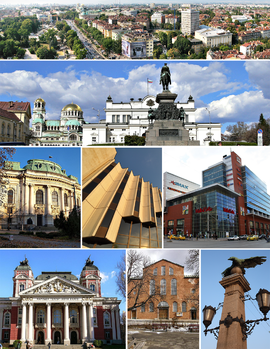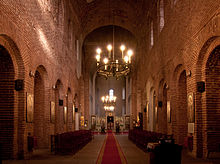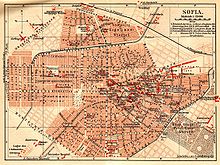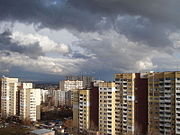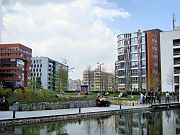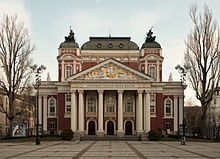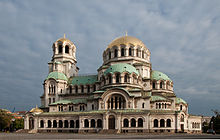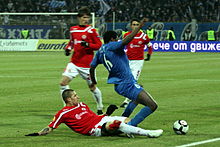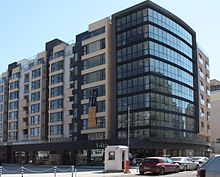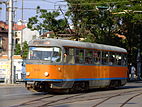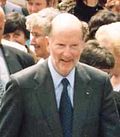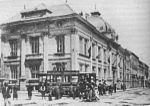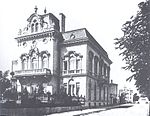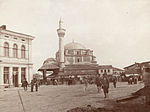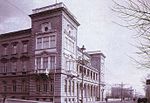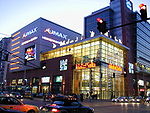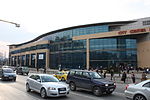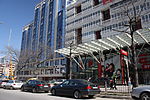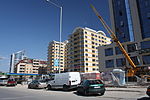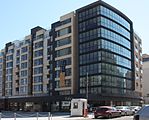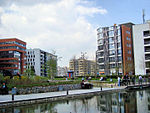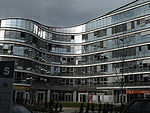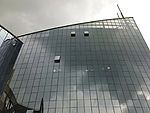- Sofia
-
This article is about the capital of Bulgaria. For other uses, see Sofia (disambiguation).
Sofia
СофияFrom top left: Tsarigrad Road, National Assembly Square, Sofia University rectorate, National Palace of Culture detail, Mall of Sofia, Ivan Vazov National Theatre, Hagia Sophia Church, Eagles' Bridge detail 
Flag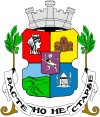
Coat of armsMotto: Расте, но не старее
(Grows but Does not Age)[1]Position of Sofia in Bulgaria Coordinates: 42°42′N 23°20′E / 42.7°N 23.333°ECoordinates: 42°42′N 23°20′E / 42.7°N 23.333°E Country  Bulgaria
BulgariaProvince Sofia-Capital Settled by Thracians as Serdica 7th century BC Government – Mayor of Sofia Yordanka Fandakova Area – City 492 km2 (190 sq mi) Elevation 550 m (1,804 ft) Population (Census 2011 (City and Urban),[2]
Forecast 2011 (Metro)[3])– City 1 232 088 – Density 944/km2 (2,444.9/sq mi) – Urban 1,291,591 – Metro 1,370,000 (Metro area) Time zone EET (UTC+2) – Summer (DST) EEST (UTC+3) Postal code 1000 Area code(s) (+359) 02 Website www.Sofia.bg Sofia (Bulgarian: София, Sofiya, pronounced [ˈsɔfijɐ] (
 listen)) is the capital and largest city of Bulgaria and the 12th largest city in the European Union with a population of 1.27 million people.[4] It is located in western Bulgaria, at the foot of Mount Vitosha and is ranked as a Beta- world city.[5]
listen)) is the capital and largest city of Bulgaria and the 12th largest city in the European Union with a population of 1.27 million people.[4] It is located in western Bulgaria, at the foot of Mount Vitosha and is ranked as a Beta- world city.[5]Prehistoric settlements were excavated in the centre of the present city, near the royal palace, as well as in outer districts such as Slatina and Obelya.[6] The well-preserved town walls (especially their substructures) from antiquity date back before the 7th century BC, when Thracians established their city next to the most important and highly respected mineral spring, still functioning today. Sofia has had several names in the different periods of its existence, and remnants from the city's past can still be seen today alongside modern landmarks. Its ancient name, Serdica, derives from the local Celtic tribe of the serdi who inhabited the region since the 1st century BC.[7]
Many of the major universities, institutions, and businesses of Bulgaria are concentrated in Sofia. It is also a center of media, cultural events, modern theaters, it is a home of research institutes, sporting events, orchestras, and museums. IT industry sector is gradually growing in Sofia, together with the increasing number of events in contemporary arts, festivals, etc.
Contents
Names
Sofia was first mentioned in the sources as Serdica in relation to Marcus Licinius Crassus' campaigns in 59 BC. The name Serdica or Sardica (Σερδική, Σαρδική) was popular in Latin, Ancient Greek and Byzantine Greek sources from Antiquity and the Middle Ages; it was related to the local Celtic[8] tribe of the Serdi. The name was last used in the 19th century in a Bulgarian text, Service and hagiography of Saint George the New of Sofia: ВЪ САРДАКІИ. Another of Sofia's names, Triaditsa (Τριάδιτζα), was mentioned in Greek medieval sources. The Bulgarian name Sredets (СРѢДЄЦЪ), which is related to среда sreda (middle), first appeared in the 11th-century Vision of Daniel and was widely used in the Middle Ages. The current name Sofia was first used in the 14th-century Vitosha Charter of Bulgarian tsar Ivan Shishman or in a Ragusan merchant's notes of 1376; it refers to the famous Hagia Sophia Church, an ancient church in the city named after the Christian concept of the Holy Wisdom. Although Sredets remained in use until the late 18th century, Sofia gradually overcame the Slavic name in popularity.[9] During the Ottoman rule it was called Sofya by the Turkish conquerors of Bulgaria.
The city's name is pronounced by Bulgarians with a stress on the 'o', in contrast with the tendency of foreigners to place the stress on 'i'. Interestingly, the female given name "Sofia" is pronounced by Bulgarians with a stress on the 'i'.
Geography
Sofia's development as a significant settlement owes much to its central position in the Balkans. It is situated in western Bulgaria, at the northern foot of the Vitosha mountain, in the Sofia Valley that is surrounded by mountains on all sides. The valley is the largest in the country with territory of 1,186 square kilometres (458 sq mi) and average altitude of 550 metres (1,800 ft). Three mountain passes lead to the city, which have been key roads since antiquity, connecting the Adriatic Sea and Central Europe with the Black and Aegean Seas. A number of low rivers cross the city, including the Vladaiska and the Perlovska. The Iskar River in its upper course flows near eastern Sofia. The city is known for its numerous mineral and thermal springs. Artificial and dam lakes were built in the last century.
It is located 130 kilometres (81 mi) northwest of Plovdiv,[10] Bulgaria's second largest city, 340 kilometres (210 mi) west of Burgas[10] and 380 kilometres (240 mi) west of Varna,[10] Bulgaria's major port-cities on the Bulgarian Black Sea Coast. The city is situated at less than 200 kilometres (120 mi) from the borders with three countries: 55 kilometres (34 mi) from Kalotina on the Serbian border, 113 kilometres (70 mi) from Gyueshevo on the frontier with the Republic of Macedonia and 183 kilometres (114 mi) from the Greek border at Kulata.
Climate
Sofia has a humid continental climate with high temperature amplitudes. It is one of the coldest cities in Bulgaria with an annual temperature of 10.5 °C (50.9 °F). Annual clear days vary from 39 to 68, while annual rainy or stormy days vary from 141 to 185.[11]
Winters are very cold, and summers are warm. The coldest month is January, when the temperature can drop down to −22 °C (−8 °F) in some places. The temperature can even reach 35 °C (95 °F), but Sofia generally remains cooler than other parts of Bulgaria, due to the high altitude of the valley in which it is situated. Thunderstorms often occur during the summer season. The city receives around 650 millimetres (26 in) annual precipitation with summer maximum and winter minimum.
Climate data for Sofia, Bulgaria Month Jan Feb Mar Apr May Jun Jul Aug Sep Oct Nov Dec Year Record high °C (°F) 17.9
(64.2)22
(72)27.5
(81.5)30.3
(86.5)34
(93)38
(100)41
(106)39.4
(102.9)36.1
(97.0)33.9
(93.0)24.6
(76.3)20.1
(68.2)41
(106)Average high °C (°F) 2.2
(36.0)4.9
(40.8)9.8
(49.6)15.7
(60.3)20.3
(68.5)23.5
(74.3)25.9
(78.6)26
(79)22.6
(72.7)16.6
(61.9)9.6
(49.3)4.1
(39.4)15.1 Daily mean °C (°F) −2
(28)−0.5
(31.1)5
(41)11
(52)16
(61)19
(66)21
(70)21
(70)18
(64)12
(54)7
(45)0
(32)10.5 Average low °C (°F) −4.9
(23.2)−2.9
(26.8)0.3
(32.5)4.8
(40.6)9
(48)12.1
(53.8)13.8
(56.8)13.4
(56.1)10.4
(50.7)5.7
(42.3)1.2
(34.2)−2.7
(27.1)5.3 Record low °C (°F) −31.2
(−24.2)−25
(−13)−16.1
(3.0)−6
(21)−2
(28)1.4
(34.5)4
(39)3.9
(39.0)−1
(30)−6
(21)−17.8
(0.0)−20
(−4)−31.2
(−24.2)Rainfall mm (inches) 42
(1.65)31
(1.22)37
(1.46)55
(2.17)71
(2.8)90
(3.54)59
(2.32)43
(1.69)42
(1.65)55
(2.17)52
(2.05)44
(1.73)621
(24.45)% humidity 84 78 72 66 68 67 62 61 68 75 83 85 72.41 Avg. snowy days 9 10 7 2 0 0 0 0 0 1 5 10 44 Sunshine hours 62.15 81.92 118.65 166.67 206.22 248.6 285.32 268.37 194.25 135.6 79.1 48.02 1,894.87 Source no. 1: My Forecast[12] Source no. 2: Meteo.BG[13] History
Main article: History of SofiaAntiquity
Sofia was originally a Thracian settlement called Serdica, or Sardica, possibly named after the Celtic tribe Serdi.[8] For a short period during the 4th century BC, the city was ruled by Philip of Macedon and his son Alexander the Great. Around BC 29, Serdica was conquered by the Romans. It became a municipium, or centre of an administrative region, during the reign of Emperor Trajan (98–117) and was renamed Ulpia Serdica. It seems that the first written mention of Serdica was made by Ptolemy (around 100 AD). Serdica (Sardica) expanded, as turrets, protective walls, public baths, administrative and cult buildings, a civic basilica, an amphitheatre – the City Council (Boulé), a large Forum, a big Circus (Theatre), etc. were built.
When Emperor Diocletian divided the province of Dacia into Dacia Ripensis (at the banks of the Danube) and Dacia Mediterranea, Serdica became the capital of Dacia Mediterranea. The city subsequently expanded for a century and a half, it became a significant political and economical centre, moreso — it became one of the first Roman cities where Christianity was recognized as an official religion (Еmperor Galerius). In 343 AD, the Council of Sardica was held in the city, in a church located where the current 6th century Church of Saint Sophia was later built.
The city was destroyed in the 447 invasion of the Huns. It was rebuilt by Byzantine Emperor Justinian I and for a while called Triaditsa or Sredets by the slavonic tribes. During the reign of Justinian it flourished, being surrounded with great fortress walls whose remnants can still be seen today.
Middle Ages and Ottoman rule
Sofia first became part of the First Bulgarian Empire during the reign of Khan Krum in 809, after a long siege.[14] Afterwards, it was known by the Bulgarian name "Sredets" and grew into an important fortress and administrative centre. After the fall of North-eastern Bulgaria under John I Tzimiskes' armies in 971, the Bulgarian Patriarch Damyan chose Sofia for his seat in the next year. After a number of unsuccessful sieges, the city fell to the Byzantine Empire in 1018, but once again was incorporated into the restored Bulgarian Empire at the time of Tsar Ivan Asen I.
From the 12th to the 14th century, Sofia was a thriving centre of trade and crafts. It is possible that it had been called by the common population Sofia (meaning "wisdom" in Ancient Greek) about 1376 after the church of Saint Sophia. However, in different testimonies it was called both "Sofia" and "Sredets" until the end of the 19th century. In 1382, Sofia was seized by the Ottoman Empire in the course of the Bulgarian-Ottoman Wars after a long siege.
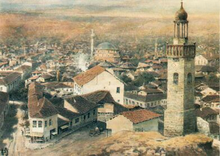 Sofia in mid 19th century, when Bulgarians were at Ottoman Rule and the city was in the territories of the Ottoman empire
Sofia in mid 19th century, when Bulgarians were at Ottoman Rule and the city was in the territories of the Ottoman empire
After the failed crusade of Władysław III of Poland in 1443 towards Sofia, the city's Christian elite was annihilated and the city became the capital of the Ottoman province (beylerbeylik) of Rumelia for more than four centuries, which encouraged many Turks to settle there. In the 16th century, Sofia's urban layout and appearance began to exhibit a clear Ottoman style, with many mosques, fountains and hamams (bathhouses). During that time the town had a population of around 7,000.
The town was seized for several weeks by Bulgarian hayduts in 1599. In 1610 the Vatican established the See of Sofia for Catholics of Rumelia, which existed until 1715 when most Catholics had emigrated.[15] In the 16th century there were 126 Jewish households, and there has been a synagogue in Sofia since 967. The town was the center of Sofya Eyalet (1826–1864).
After 1878
Sofia was taken by Russian forces on January 4, 1878, during the Russo-Turkish War, 1877–78, and became the capital of the autonomous Principality of Bulgaria in 1879, which became the Kingdom of Bulgaria in 1908. It was proposed as a capital by Marin Drinov and was accepted as such on 3 April 1879. After the Liberation War, the new name "Sofia" replaced the old one ("Sredets"). Quite some time after 1878 there was a strong will, expressed by Bulgarian committees, to keep the name Sredets, but the Russian administration accepted Sofia.[citation needed] By the time of its liberation the population of the city was 11,649.[16] For a few decades after the liberation the city experienced large population growth mainly from other regions of the country.
During World War II, Sofia was bombed by Allied aircraft – British and USA aircraft, in late 1943 and early 1944. As a consequence of the invasion of the Soviet Red Army, Bulgaria's government, which was allied with Germany, was overthrown.
The transformations of Bulgaria into a People's Republic in 1946 and Republic of Bulgaria marked significant changes in the city's appearance. The population of Sofia expanded rapidly due to migration from the country. Whole new residential areas were built in the outskirts of the city, like Druzhba, Mladost and Lyulin.
Cityscape
Districts
Main article: Sofia districts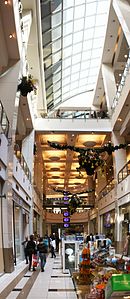 Mall of Sofia in Vazrazhdane
Mall of Sofia in Vazrazhdane
Politically, administratively and economically, Bulgaria is a highly centralised state, making Sofia a national administrative unit of its own right. It should not to be confused with Sofia Province, which surrounds but does not include the city itself. Besides the city proper, the capital province encompasses three other cities and 34 villages, being split into a total of 24 districts.[17] Each of them has its own district mayor who is elected in a popular election.[17] The head of the Sofia Municipality is its mayor. The assembly members are chosen every four years. The current mayor of Sofia is Yordanka Fandakova.
The following are some of the most culturally and economically significant districts:
- Oborishte is in the very center of the city, where most landmarks and administrative edifices are located. It is known for its predominantly neo-Renaissance and Viennese architecture, extensive green belts and yellow cobblestones.
- Sretets neighbours Oborishte and shares some of its specific architecture. It is the site of Borisova gradina (Gardens of Boris) and the Vasil Levski National Stadium.
- Vazrazhdane is an economically active district where many trade centres and banks, along with some light industry manufacturing companies, are located. One of its main boulevards is Marie Louise Boulevard, the site of the Central Sofia Market Hall, TZUM and St Nedelya Church.
- Mladost is the one of the largest districts in terms of population (second only to Lyulin) with its 110,000 inhabitants. It is generally poor in landmarks and administrative institutions, but it concentrates the headquarters of numerous domestic and international companies, large-scale department stores, official vehicle dealerships, and Business Park Sofia at its southern end. The architecture is a combination of Socialist-era apartment blocks, industrial enterprises and new buildings, most of which were constructed after 2004. Mladost has excellent transport connections to all remaining districts of Sofia.
- Vitosha is located on the foot of Vitosha Mountain. It holds a key location as it is the site where the Sofia ring road and Bulgaria Boulevard cross. Luxury estates and villa complexes dominate in Vitosha district. It has good connections to both the city centre and the nearby mountain resorts. Boyana is the site of the presidential residence, the Nu Boyana Film studios, the National Historical Museum and the Boyana Church.
Architecture
The outlook of Sofia combines a wide range of arhitectural styles, some of which are hardly compatible. These vary from Christian Roman architecture and medieval Bulgar fortresses to Neoclassicism and prefabricated Socialist-era apartment blocks (panelki). A number of ancient Roman, Byzantine and medieval Bulgarian buildings are preserved in the centre of the city. These include the 10th century Boyana Church (a World Heritage Site), the 4th century Rotunda of St. George, the walls of the Serdica fortress and the partially preserved Amphitheatre of Serdica.
Architectural styles in Sofia Banya Bashi Mosque, one of the few surviving examples of Islamic architectureLate 19th century houses in OborishteThe Largo, an example of Stalinist architecturePrefabricated apartments in MladostBusiness Park SofiaAfter the Liberation War, knyaz Alexander Battenberg invited architects from Austria–Hungary to shape the new capital's architectural appearance.[18] Among the architects invited to work in Bulgaria were Friedrich Grünanger, Adolf Václav Kolář, Viktor Rumpelmayer and others, who designed the most important public buildings needed by the newly-reestablished Bulgarian government, as well as numerous houses for the country's elite.[18] Later, many foreign-educated Bulgarian architects also contributed. The architecture of Sofia's centre is thus a combination of Neo-Baroque, Neo-Rococo, Neo-Renaissance and Neoclassicism, with the Vienna Secession also later playing an important part, but it is mostly typically Central European.
After the Second World War and the establishment of a Communist government in Bulgaria in 1944, the architectural line was substantially altered. Stalinist Gothic public buildings emerged in the centre, notably the spacious government complex around The Largo, Vasil Levski Stadium, the Cyril and Methodius National Library and others. As the city grew outwards, the then-new neighbourhoods were dominated by many concrete tower blocks, prefabricated panel apartment buildings and examples of Brutalist architecture.
After the abolition of Communism in 1989, Sofia has witnessed the construction of whole business districts and neighbourhoods, as well as modern skryscraper-like glass-fronted office buildings, but also top-class residential neighbourhoods. However, the end of the old administration and centrally planned system also paved the way for chaotic and unrestrained construction, which continues to the present day.
Green areas
 An aerial view of central Sofia over Orlov Most. The extensive tree lines around the centre are clearly visible
An aerial view of central Sofia over Orlov Most. The extensive tree lines around the centre are clearly visible
The city has an extensive green belt, and almost all streets have a greenway of century-old trees. The only exception are some of the neighbourhoods constructed after 2000, which are densely built-up and often lack green spaces. There are four principal parks – Borisova gradina in the city centre and the Southern, Western and Northern parks. Several other smaller parks, among which the City Garden and the Doctors' Garden, are located in central Sofia. The Vitosha Nature Park (the oldest national park in the Balkans [19]), which includes a large portion of Vitosha mountain, covers an area of almost 270 km² and lies entirely within the city limits.[20] Many of the city's residents take weekly hikes up the mountain, and most do so at least a couple of times a year. There are bungalows as well as several ski slopes on Vitosha, allowing locals to take full advantage of the countryside and of the mountains without having to leave the city.
Culture
See also: Tourist attractions in SofiaSee also: List of churches in SofiaArts and entertainment
Sofia concentrates the majority of Bulgaria's leading performing arts troupes. Theatre is by far the most popular form of performing art, and theatrical venues are among the most visited, second only to cinemas. The oldest such institution is the Ivan Vazov National Theatre, which performs mainly classical plays and is situated in the very centre of the city. A large number of smaller theatres, such as the Sfumato Theatrical Workshop, show both classical and modern plays.
The National Opera and Ballet is a combined opera and ballet collective, established in 1891. However, it did not begin performances on a regular basis until 1909. Some of Bulgaria's most famous operatic singers, such as Nicolai Ghiaurov and Ghena Dimitrova, have made their first appearances on the stage of the National Opera and Ballet. Bulgaria Hall and Hall 1 of the National Palace of Culture regularly hold classical concerts, performed both by foreign orchestras and the Sofia Philharmonic. The city has played host to many world-famous musical acts including Sting, Elton John, Madonna, George Michael, Tiesto, Kylie Minogue, Depeche Mode, Rammstein, Rihanna and Roxette.
Visual arts expositions are also of interest. The National Art Gallery holds a collection of works mostly by Bulgarian authors, while the National Gallery for Foreign Art displays exclusively foreign art, mostly from India, Africa, China and Europe. Its collections encompass diverse cultural items such as Ashanti Empire sculptures, Buddhist art, Dutch Golden Age painting, works by Albrecht Dürer, Jean-Baptiste Greuze and Auguste Rodin, among others. The crypt of the Alexander Nevsky cathedral holds a collection of Eastern Orthodox icons from the 9th to the 19th century.
Cinema is the most popular form of entertainment. In recent years, cinematic venues have been concentrating in trade centres and malls, and independent halls have been closed. Mall of Sofia holds one of the largest IMAX cinemas in Europe. Most films are American productions, although European and domestic films are increasingly shown. Odeon (not part of the Odeon Cinemas chain) shows exclusively European and independent American films, as well as 20th century classics. Bulgaria's once thriving film industry, concentrated in the Boyana Film studios, has suffered a period of decay after 1990. A relative revival of the industry began after 2001. After the acquisition of Boyana Film by Nu Image, several moderately successful productions have been shot in and around Sofia, such as The Contract, The Black Dahlia, Hitman and Conan the Barbarian. The Nu Boyana Film studios have also hosted some of the scenes for The Expendables 2.
The city houses many cultural institutes such as the Russian Cultural Institute, the Polish Cultural Institute, the Hungarian Institute, the Czech and the Slovak Cultural Institutes, the Italian Cultural Institute, the French Cultural Institute, Goethe Institut, British Council, Instituto Cervantes, and the Open Society Institute, which regularly organise temporary expositions of visual, sound and literary works by artists from their respective countries.
Some of the biggest telecommunications companies, TV and radio stations, newspapers, magazines, and web portals are based in Sofia, including the Bulgarian National Television, bTV and Nova TV. Top-circulation newspapers include 24 Chasa, Trud and Kapital Daily.
Tourism
Sofia is one of the most visited tourist destinations in Bulgaria alongside coastal and mountain resorts. Among its highlights is the Alexander Nevsky Cathedral, one of the symbols of Bulgaria, constructed in the late 19th century. It occupies an area of 3,170 square metres (34,100 sq ft) and can hold 10,000 people. The city is also known for the Boyana Church, a UNESCO world heritage site. The SS. Cyril and Methodius National Library houses the largest national collection of books and documents (1,714,211 books and some 6 million other documents[21]) and is Bulgaria's oldest cultural institute.
Sofia also holds Bulgaria's largest museum collections, which attract both tourists and students for practical studies. The National Historical Museum in Boyana district has a vast collection of more than 650,000 historical items dating from Prehistory to the modern era, although only 10,000 of them are permanently displayed due to the lack of space.[22] Smaller collections of items related mostly to the history of Sofia are located in the National Archaeological Museum, a former mosque located between the edifices of the National Bank and the Presidency. Two natural sciences museums - the Natural History Museum and the Earth and Man display a variety of minerals, animal species (both alive and taxidermic) and rare materials. The Ethnographic Museum and the National Museum of Military History are other places of interest, holding large collections of Bulgarian folk costumes and various armaments, respectively.
Vitosha Boulevard, also called Vitoshka, has numerous fashion boutiques and luxury goods stores. Sofia's geographic location, situated in the foothills of the weekend retreat Vitosha mountain, further adds to the city's specific atmosphere.
Sports
A large number of sports clubs are based in the city. During the Communist era most sports clubs concentrated on all-round sporting development, therefore CSKA, Levski and Slavia are dominant not only in football, but in many other team sports as well. Basketball and volleyball also have strong traditions in Sofia. A notable local basketball team is twice European Champions Cup finalist Lukoil Akademik. The Bulgarian Volleyball Federation is the world's second-oldest, and it was an exhibition tournament organised by the BVF in Sofia that convinced the International Olympic Committee to include volleyball as an olympic sport in 1957.[23] Tennis is increasingly popular in the city. Currently there are some ten[24] tennis court complexes within the city including the one founded by former WTA top-ten athlete Magdalena Maleeva.[25]
Sofia applied to host the Winter Olympic Games in 1992 and in 1994, coming 2nd and 3rd respectively. The city was also an applicant for the 2014 Winter Olympics, but was not selected as candidate. In addition, Sofia hosted Eurobasket 1957 and the 1961 and 1977 Summer Universiades, as well as the 1983 and 1989 winter editions. In 2012, it will host the FIVB World League finals.
The city is home to a number of large sports venues, including the 43,000-seat Vasil Levski National Stadium which hosts international football matches, and Lokomotiv Stadium, the main venue for outdoor musical concerts. Armeets Arena holds many indoor events and has a capacity of up to 19,000 people depending on its use. There are two ice skating complexes — the Winter Palace of Sports with a capacity of 4,000 and the Slavia Winter Stadium with a capacity of 2,000, both containing two rinks each.[26] A velodrome with 5,000 seats in the city's central park is currently undergoing renovation.[27] There are also various other sports complexes in the city which belong to institutions other than football clubs, such as those of the National Sports Academy, the Bulgarian Academy of Sciences, or those of different universities. There are more than fifteen swimming complexes in the city, most of them outdoor.[28] Nearly all of these were constructed as competition venues and therefore have seating facilities for several hundred people.
There are two golf courses just to the east of Sofia — in Elin Pelin (St Sofia club) and in Ihtiman (Air Sofia club), and a horseriding club (St George club).
Demographics
The rapid expansion of the population after 2000 largely contributed to a construction boom, which lasted until 2009 and saw the creation of many new apartment buildings, such as this one in Borovo.
According to 2010 data,[29] the whole Capital Municipality, with a population of 1,376,467 and had a population density of 926.5.
The ratio of women per 1,000 men was 1,102. The birth rate per 1000 people was 12.3 per mille and steadily increasing in the last 5 years, the death rate reaching 12.1 per mille and decreasing. The natural growth rate during 2009 was 0.2 per mille, the first positive growth rate in nearly 20 years. The considerable immigration to the capital from poorer regions of the country, as well as urbanisation, are among the other reasons for the increase in Sofia's population. 4.8 people of every one thousand were wedded in 2009 (only heterosexual marriage is possible in Bulgaria) and the infant mortality rate was 5.6 per 1,000, down from 18.9 in 1980.
According to the 2001 census, Sofia's population is made up of 96% ethnic Bulgarians; among minority communities, nearly 18,000 (1.5%) officially identified themselves as Roma,[30] 6,000 as Turkish, 3,000 as Russian, 1,700 as Armenian, and 1,200 as Greek.[31]
The unemployment is lower than in other parts of the country — 2.45% of the active population in 1999 and declining, compared to 7.25% for the whole of Bulgaria as of 1 July 2007.[32] The large share of unemployed people with higher education, 27% as compared to 7% for the whole country, is a characteristic feature of the capital.
Sofia was declared capital in 1879. One year later, in 1880, it was the fifth-largest city in the country after Plovdiv, Varna, Ruse and Shumen. Plovdiv remained the most populous Bulgarian town until 1892 when Sofia took the lead.
Economy
Sofia is the economic heart of Bulgaria and home to most major Bulgarian and international companies operating in the country, as well as the Bulgarian National Bank and the Bulgarian Stock Exchange. With a nominal GDP of 20.59 billion leva (US $14.24 billion),[33] and a PPS GDP per capita of the city and its surrounding Yugozapaden NUTS II planning region of $25,130,[34] the capital is the centre of the national economy. In 2007, the average per capita monthly income was 3,828 leva ($2,648),[35] substantially higher than the national average of 689 leva ($477).[36] The strongest sectors of the city's economy in terms of annual production are manufacturing ($5.5 bln.), metallurgy ($1.84 bln.), electricity, gas and water supply ($1.6 bln.) and food and beverages ($778 mln.).[37]
After World War II and the era of industrialisation under socialism, the city and its surrounding areas expanded rapidly and became the most heavily industrialised region of the country.[38] The influx of workers from other parts of the country became so intense that a restriction policy was imposed, and residing in the capital was only possible after obtaining Sofianite citizenship.[38]
Increasingly, Sofia is becoming an outsourcing destination for multinational companies, among them IBM, Hewlett-Packard, SAP, Siemens, Software AG.[citation needed] Bulgaria Air, the national airline of Bulgaria, has its head office on the grounds of Sofia Airport.[39]
Up until 2007 Sofia experienced rapid economic growth. In 2008, apartment prices increased dramatically, with a growth rate of 30%.[40] In 2009, prices fell by 26%.[41]
Transport and infrastructure
Left: A vintage 1960s Czech Tatra T4D tram.
Right: A 2005-manufactured Rusich train at Musagenitsa Metro StationWith its developing infrastructure and strategic location, Sofia is a major hub for international railway and automobile transport. Three Trans-European Transport Corridors cross the city: 4, 8 and 10. All major types of transport (except water) are represented in the city. It is home to eight railway stations,[42] the biggest of which is the Central Railway Station. Just next to it is the new Central Bus Station.[43] A number of other bus stations allow interurban and international trips from different parts of the city. The Sofia Airport with its new second terminal, finished in 2006, [44] handled some 2.7 million passengers in 2007. [45]
Public transport is well-developed with bus, tram (153,6 km network[42]) and trolleybus (97 km network[42]) lines running in all areas of the city,[46] [47] although most vehicles are in a poor condition. The Sofia Metro became operational in 1998, and now has one line and 14 stations.[48] As of 2011, the system has 18 kilometers of track. Six new stations opened in 2009. Construction works on the extension of the first line are ongoing; two new stations are expected to be completed in 2012. A second line with 11 stations is under construction with a targeted completion date in 2012. A third line is currently under consideration. [48] The master plan for the Sofia Metro includes three lines with a total of 47 stations.[48] In recent years the marshrutka, a private passenger van, began serving fixed routes and proved an efficient and popular means of transport by being faster than public transport but cheaper than taxis. As of 2005 these vans numbered 368 and serviced 48 lines around the city and suburbs.[42] There are some 6,000 licensed taxi cabs operating in the city and another 2,000 operating somewhat illegally. [49] Low fares in comparison with other European countries, make taxis affordable and popular among a big part of the city population.
Private automobile ownership has grown rapidly in the 1990s; more than 1,000,000 cars were registered in Sofia after 2002. The city has the 5th-highest number of automobiles per capita in the European Union at 546.4 vehicles per 1,000 people.[50] The municipality is known for minor and cosmetic repairs and many streets are in a poor condition. There are different boulevards and streets in the city with a higher amount of traffic than others. These include Cherni Vrah, Bulgaria, and Todor Aleksandrov boulevards, where long chains of cars are formed at peak hours and traffic jams occur regularly.[51] Consequently traffic and air pollution problems have become more severe and receive regular criticism in local media. The extension of the underground system is hoped to alleviate the city's immense traffic problems.
Sofia has a unique, very large combined heat and power (CHP) plant. Virtually the entire city (900,000 households and 5,900 companies) is centrally heated, using residual heat from electricity generation (3,000 MW) and gas- and oil-fired heating furnaces; total heat capacity is 4,640 MW. The heat distribution piping network is 900 km long and comprises 14,000 substations and 10,000 heated buildings.
Education
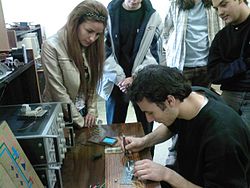 Students practicing with electronic devices at the Technical University of Sofia.
Students practicing with electronic devices at the Technical University of Sofia.
There are 16 universities in Sofia. The Saint Clement of Ohrid University of Sofia is often regarded as the most prestigious university of Bulgaria, founded in 1888[52] The University enrolls 14,000 students annually. Other important universities include the National Academy of Arts, the Technical University of Sofia, the University for National and World Economics, Sofia Medical University, the Krastyo Sarafov National Academy for Theatre and Film Arts, the University of Architecture, Civil Engineering and Geodesy, the University of Forestry, the State University of Library Studies and Information Technologies and New Bulgarian University.
The St. Clement of Ohrid University of Sofia is the oldest higher education institution in Bulgaria, founded on 1 October 1888. The university's edifice was constructed between 1924 and 1934 with the financial support of the brothers Evlogi Georgiev and Hristo Georgiev.[53]
Furthermore, institutions of national significance, such as the Bulgarian Academy of Sciences and the SS. Cyril and Methodius National Library are located in Sofia. The American College of Sofia, founded in 1860 and often regarded as the oldest American academic institution outside the United States,[54] provides secondary education to some of Bulgaria's brightest students.
Notable residents
- See also: Category:People from Sofia
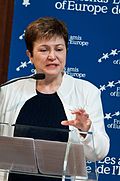 Kristalina Georgieva, European commissioner
Kristalina Georgieva, European commissioner
Notable people born in Sofia:
- Georgi Asparuhov (1943–1971), football player
- Michael Bar-Zohar (b. 1938), historian, former Knesset member
- Irina Bokova (b. 1952), politician, current director-general of UNESCO
- Boris III (1894–1943), Tsar of Bulgaria
- Laura Chukanov (b. 1986), model, Miss Utah USA 2009, Miss USA 2009 (3rd runner-up)
- Cyril (1901–1971), Patriarch of Bulgaria
- Albena Denkova (b. 1974), ice dancer, World Championship gold, silver, bronze
- Nina Dobrev, (b. 1989), actress
- Itzhak Fintzi (b. 1933), actor
- Kristalina Georgieva (b. 1953), politician, European Commissioner for International Cooperation, Humanitarian Aid and Crisis Response in the second college of the Barroso Commission.
- Maria Gigova (b. 1947), three times rhythmic gymnastics World champion
- Assen Jordanoff (1896–1967), Bulgarian-American aviation pioneer
- Matey Kaziyski (b. 1984), volleyball player
- Plamen Konstantinov (b. 1973), volleyball player
- Ivan Kostov (b. 1953), politician
- Nikola Kotkov (1938–1971), football player
- Ivet Lalova (b. 1983), athlete, fastest female white sprinter in the world
- Lydia Lazarov (b. 1946), Israeli former yachting world champion
- Borislav Mikhailov (b. 1963), football player and Bulgarian Soccer Union president, member of the executive committee of UEFA
- Moni Moshonov (b. 1951), Israeli actor, comedian and theater director.
- Stoyanka Mutafova (b. 1922), actress
- Valeri Petrov (b. 1920), writer
- Evgenia Radanova (b. 1977), ice skater
- Anna-Maria Ravnopolska-Dean (b. 1960), harpist
- Simeon II (b. 1937), former Tsar of Bulgaria and former Prime Minister of Bulgaria
- Antoaneta Stefanova (b. 1979), chess player and Women's World Chess Champion
- Tzvetan Todorov (b. 1939), philosopher and writer
- Alexis Weissenberg (b. 1929), pianist
- Andrey Zhekov (b. 1980), volleyball player
- Lyudmila Zhivkova (1942-1981), art historian and politician
International relations
Twin towns — Sister cities
Sofia is twinned with:
 Algiers, Algeria
Algiers, Algeria Ankara, Turkey (since 1992)
Ankara, Turkey (since 1992) Berlin, Germany
Berlin, Germany Bratislava, Slovakia (since 2008)[citation needed]
Bratislava, Slovakia (since 2008)[citation needed] Brussels, Belgium
Brussels, Belgium Bucharest, Romania
Bucharest, Romania Budapest, Hungary
Budapest, Hungary Bursa, Turkey (since 1998)
Bursa, Turkey (since 1998) Helsinki, Finland
Helsinki, Finland Kiev, Ukraine (since 1997)
Kiev, Ukraine (since 1997) London, United Kingdom
London, United Kingdom Madrid, Spain
Madrid, Spain Milan, Italy
Milan, Italy Paris, France (since 1998)
Paris, France (since 1998) Pittsburgh, United States
Pittsburgh, United States Prague, Czech Republic
Prague, Czech Republic Saint Petersburg, Russia
Saint Petersburg, Russia Maraş, Turkey
Maraş, Turkey Tel Aviv, Israel (since 1992)
Tel Aviv, Israel (since 1992) Tirana, Albania (since 2008)[55][56]
Tirana, Albania (since 2008)[55][56] Yerevan, Armenia (since 2008)
Yerevan, Armenia (since 2008) Warsaw, Poland
Warsaw, Poland Salalah, Oman,(since 4 August 2011)
Salalah, Oman,(since 4 August 2011)
Honour
Serdica Peak on Livingston Island in the South Shetland Islands, Antarctica is named after Serdica.
Images of old Sofia
-
The former buildings of Agricultural Bank and the National Library in 1910. The latter being destroyed during the Allied air raids of 1943–1944.
-
The former building of the Bulgarian National Bank in 1910.
-
The rectorate of Sofia University in 1935.
-
Ivan Vazov National Theatre in 1910.
-
The Russian Church in 1916.
-
Ivan Vazov National Theatre in 1910.
-
Tsar Osvoboditel Boulevard in 1916.
-
The old Central Railway Station (demolished in 1972).
-
St Nedelya Church in 1922, before the 1925 bombing
21st century Sofia
-
Office buildings on Bulgaria blvd.
-
Office buildings on Bulgaria blvd.
-
Office buildings on Bulgaria blvd.
See also
- Bulgaria
- Europe
- List of malls in Sofia
- List of tallest buildings in Sofia
- List of villages in Sofia City
- Tourist attractions in Sofia
- Plovdiv
- Sofia Airport
- Sofia Central Bus Station
- Sofia Metro
- Sofia Province
- Sofia University
- Streets in Sofia
- Varna
References
- Notes
- ^ "Sofia Trough Centuries". Sofia Municipality. http://www.sofia.bg/en/display.asp?ime=sofia. Retrieved 2009-10-16.
- ^ Census 2011
- ^ eurometrex.org, Sofia Metro Area (1,280,000 in 2001 and 1,450,000 in 2020, equal to 1,370,000 in 2011); Sofia Metro Region (1,435,000 in 2001 and 1,540,000 in 2020, equal to 1,490,000 in 2011)
- ^ "Bulgarian Census 2011". Nsi.bg. http://webcache.googleusercontent.com/search?hl=bg&gl=bg&source=android-browser-type&q=cache:tGmhZgG6tW0J:www.nsi.bg/EPDOCS/Census2011pr.pdf. Retrieved 2011-04-14.
- ^ Sofia, The Times. Retrieved March 23, 2011
- ^ Sofia Luxury Hotels, About Sofia. Retrieved March 23, 2011
- ^ The Cambridge Ancient History, Volume 3, Part 2: The Assyrian and Babylonian Empires and Other States of the Near East, from the Eighth to the Sixth Centuries BC by John Boardman, I. E. S. Edwards, E. Sollberger, and N. G. L. Hammond, ISBN 0521227178, 1992, page 600: "In the place of the vanished Treres and Tilataei we find the Serdi for whom there is no evidence before the first century BC. It has for long being supposed on convincing linguistic and archeological grounds that this tribe was of Celtic origin."
- ^ a b "The Cambridge Ancient History", Volume 3, Part 2: The Assyrian and Babylonian Empires and Other States of the Near East, from the Eighth to the Sixth Centuries BC by John Boardman, I. E. S. Edwards, E. Sollberger, and N. G. L. Hammond, ISBN 0-521-22717-8, 1992, p. 600: "In the place of the vanished Treres and Tilataei we find the Serdi for whom there is no evidence before the first century bc.It has for long being supposed on convincing linguistic and archeological grounds that this tribe was of Celtic origin"
- ^ Чолева-Димитрова, Анна М. (2002) (in Bulgarian). Селищни имена от Югозападна България: Изследване. Речник. София: Пенсофт. pp. 169–170. ISBN 9546421685. OCLC 57603720.
- ^ a b c "Distances between cities in Bulgaria, City of Sofia". Guide Bulgaria. http://guide-bulgaria.com/Distances.aspx. Retrieved 2008-05-25.
- ^ Sofia in Figures, p.29
- ^ myforecast.com, Meo Weather. Retrieved June 2, 2011.
- ^ meteo.bg, National Institute of Meteorology and Hydrology (Bulgaria), Tables
- ^ Theophanes Confessor. Chronographia, p.485
- ^
 This article incorporates text from a publication now in the public domain: Herbermann, Charles, ed (1913). "Sardica". Catholic Encyclopedia. Robert Appleton Company. http://oce.catholic.com/index.php?title=Sardica.
This article incorporates text from a publication now in the public domain: Herbermann, Charles, ed (1913). "Sardica". Catholic Encyclopedia. Robert Appleton Company. http://oce.catholic.com/index.php?title=Sardica. - ^ (Bulgarian) Кираджиев, Светлин (2006). „София. 125 години столица. 1879–2004 година“. ИК „Гутенберг“. ISBN 978-954-617-011-8
- ^ a b "District Mayors". Sofia Municipality. http://sofia.bg/en/display.asp?ime=council. Retrieved 2009-12-26.
- ^ a b Collective (1980). Encyclopedia of Figurative Arts in Bulgaria, volume 1. Sofia: Bulgarian Academy of Sciences. pp. 209–210.
- ^ "National parks in the world (Bulgarian)". journey.bg. http://journey.bg/bulgaria/bulgaria.php?>ype=21. Retrieved 2008-05-24.
- ^ "Vitosha Mountain". www.vitoshamount.hit.bg. http://www.vitoshamount.hit.bg/. Retrieved 2008-05-11.
- ^ Фондове и колекции, Cyrl and Methodius National Library (in Bulgarian)
- ^ Колекции, National Historical Museum (in Bulgarian)
- ^ "BVA-News". www.balkanvolleyball.org. Archived from the original on 2008-02-20. http://web.archive.org/web/20080220025206/http://www.balkanvolleyball.org/News.htm. Retrieved 2008-05-11.
- ^ "Sofia municipality — Tennis courts". www.sofia.bg. http://www.sofia.bg/templkomp.asp?ime=TENISK%7D&title=%D1%F2%EE%EB%E8%F7%E5%ED%20%EA%EE%EC%EF%E0%F1&pathtitle=sport&opis=%D1%EF%EE%F0%F2. Retrieved 2008-05-11.
- ^ "Тенис Клуб Малееви". www.maleevaclub.com. http://www.maleevaclub.com/. Retrieved 2008-05-11.
- ^ "www.kunki.org: Skate rinks in Sofia". kunki.org. http://kunki.org/page.php?9. Retrieved 2008-05-11.
- ^ "Journey.bg — History of the Sofia velodrome". journey.bg. http://journey.bg/bulgaria/bulgaria.php?guide=1916. Retrieved 2008-05-11.
- ^ "Swimming pools in Sofia (including Spa centers)". tonus.tialoto.bg. http://tonus.tialoto.bg/article.php?id=2277. Retrieved 2008-05-11.
- ^ "Basic demogaraphic indicators for Sofia" (in Bulgarian). National Statistic Institute website. http://www.nsi.bg/eventbg.php?n=443. Retrieved 2010-04-05.
- ^ This statistic should not necessarily be taken at face value due to conflicting data – such as for the predominanly Roma neighbourhood of Fakulteta, which alone has a population of 45,000. Ромите са изолирани от бума в заетостта на Балканите, mediapool.bg, 11 December 2007 (Bulgarian)
- ^ 2001 Census (Bulgarian) (English – less detailed) – recovered 26 June 2008. All other ethnic groups numbered less than one thousand; nearly 15,000 people said "other" or did not give an ethnicity.
- ^ "Най-ниската безработица от 16 години насам е отчетена през юли" (in Bulgarian). Aktualno.com. 2006-08-14. http://bulgaria.actualno.com/news_74069.html. Retrieved 2006-10-15.
- ^ Sofia in Figures, p. 22
- ^ "Regional gross domestic product (PPS per inhabitant), by NUTS 2 regions". Eurostat. http://epp.eurostat.ec.europa.eu/tgm/table.do?tab=table&init=1&language=en&pcode=tgs00005&plugin=1. Retrieved 2 November 2011.
- ^ Sofia in Figures, p. 22
- ^ "Average Bulgarian Salary Up to BGN 689 March 2011". Novinite. 11 May 2011. http://www.novinite.com/view_news.php?id=128120. Retrieved 5 November 2011.
- ^ Sofia in Figures, p.106
- ^ a b The capital's changing face, The Sofia Echo
- ^ "Contacts." Bulgaria Air. Retrieved on 10 May 2010.
- ^ "Bulgaria Housing Market Favors Buyers but Far Away from Collapse". www.novinite.com. http://www.novinite.com/view_news.php?id=101086. Retrieved 2009-02-08.
- ^ "Bulgaria Residential Property Prices Down by 26% in Q4 y/y". www.novinite.com. http://www.novinite.com/view_news.php?id=112254. Retrieved 2010-01-30.
- ^ a b c d Sofia infrastructure from the official website of the Municipality (Bulgarian)
- ^ "Central Bus Station — official website (Bulgarian)". www.centralnaavtogara.bg. http://www.centralnaavtogara.bg/cbs/home.nsf/0/1A207ED29E913C47C2256FE10035BDA3?OpenDocument. Retrieved 2008-05-24.
- ^ "Sofia Airport — History". www.sofia-airport.bg. http://www.sofia-airport.bg/pages/content.aspx?tm01=109&tm02=78. Retrieved 2008-05-24.
- ^ "Sofia Airport — News". www.sofia-airport.bg. http://www.sofia-airport.bg/pages/news.aspx?lm01=106&p=1. Retrieved 2008-05-24.
- ^ "Public transport Sofia — official website (Bulgarian)". www.sumc.bg. http://www.skgt-bg.com/. Retrieved 2008-05-24.
- ^ "Transport Company Bulgaria— official website (Bulgarian)". www.dak-transport.com. http://www.dak-transport.com/. Retrieved 2009-08-21.
- ^ a b c "Metropolitan Sofia Web Place". www.metropolitan.bg. http://www.metropolitan.bg/index_bg.html. Retrieved 2008-05-24.
- ^ "National Federation of the Taxi Drivers in Bulgaria. Regional Member Sofia". nftvb.com. http://nftvb.com/sofia.htm. Retrieved 2008-05-24.
- ^ Sofia in Figures, p.26
- ^ "Fines for bad repair work – 'Dnevnik' newspaper". www.dnevnik.bg. http://www.dnevnik.bg/show/?storyid=372682. Retrieved 2008-05-24.
- ^ "Official website of the Sofia university — History". www.uni-sofia.bg. Archived from the original on 2008-03-29. http://web.archive.org/web/20080329223004/http://www.uni-sofia.bg/history-art/history/years.html. Retrieved 2008-05-31.
- ^ "American College of Sofia". www.acs.bg. Archived from the original on 2008-05-24. http://web.archive.org/web/20080524235340/http://acs.bg/en/acs_overview.php?case=3. Retrieved 2008-05-31.
- ^ This title is also claimed by Robert College, founded in 1863, due to the name and constitutional changes in the American College of Sofia's history.
- ^ "Twinning Cities: International Relations" (PDF). Municipality of Tirana. www.tirana.gov.al. http://www.tirana.gov.al/common/images/International%20Relations.pdf. Retrieved 2009-06-23.
- ^ Twinning Cities: International Relations. Municipality of Tirana. www.tirana.gov.al. Retrieved on 2008-01-25.
Further reading
- Gigova, Irina. "The City and the Nation: Sofia’s Trajectory from Glory to Rubble in WWII," Journal of Urban History, March 2011, Vol. 37 Issue 2, pp 155–175; the 110 footnotes provide a guide to the literature on the city
- Sofia in Figures 2009, annual report of the National Statistical Institute
In Bulgarian
- "Sofia — 130 Years Capital" (in Bulgarian). http://www.alphabank.bg/130.
External links
- Official Website Sofia.bg
- Business Park Sofia
- Sofia Airport
- Official Site of Sofia Public Transport
- Sofia at the Open Directory Project
- Sofia travel guide from Wikitravel
- Sofia – the history of Europe (video)
- Archival images of Sofia
- Virtual Guide to Ancient Serdica
- Sofia live webcam – the Russian monument
Historical Capitals of Bulgaria 
Blagoevgrad · Burgas · Dobrich · Gabrovo · Haskovo · Kardzhali · Kyustendil · Lovech · Montana · Pazardzhik · Pernik · Pleven · Plovdiv · Razgrad · Ruse · Shumen · Silistra · Sliven · Smolyan · Sofia-Capital · Sofia Province · Stara Zagora · Targovishte · Varna · Veliko Tarnovo · Vidin · Vratsa · Yambol

Capital cities of the Member States of the European Union 
Capitals of European states and territories Western Northern Central Southern Eastern Amsterdam, 6 Netherlands
Andorra la Vella, Andorra
Belfast, Northern Ireland
Brussels, 5 Belgium
Douglas, Isle of Man 4
Cardiff, Wales
Dublin, Ireland
Edinburgh, Scotland
Lisbon, Portugal
London, United Kingdom, England
Luxembourg, Luxembourg
Madrid, Spain
Monaco, Monaco
Paris, France
Saint Helier, Jersey 4
Saint Peter Port, Guernsey 4Ankara, Turkey 1
Athens, Greece
Gibraltar, Gibraltar 4
Nicosia, Cyprus 2
North Nicosia, Northern Cyprus 2, 3
Podgorica, Montenegro
Pristina, Kosovo 3
Rome, Italy
San Marino, San Marino
Sarajevo, Bosnia and Herzegovina
Skopje, Republic of Macedonia
Sofia, Bulgaria
Tirana, Albania
Valletta, Malta
Vatican City, Vatican CityAstana, Kazakhstan 1
Baku, Azerbaijan 1
Bucharest, Romania
Chişinău, Moldova
Kiev, Ukraine
Minsk, Belarus
Moscow, Russia 1
Stepanakert, Nagorno-Karabakh 2, 3
Sukhumi, Abkhazia 2, 3
Tbilisi, Georgia 1
Tiraspol, Transnistria 3
Tskhinvali, South Ossetia 2, 3
Yerevan, Armenia 11 Transcontinental country. 2 Entirely in Southwest Asia but having socio-political connections with Europe. 3 Partially recognised country. 4 Crown Dependency or Overseas Territory of the United Kingdom. 5 Also the seat of the European Union, see Location of European Union institutions and Brussels and the European Union. 6 Also the capital of the Kingdom of the Netherlands. 7 Also the capital of the Kingdom of Denmark.Categories:- Sofia
- Capitals in Europe
- Provinces of Bulgaria
- Populated places established in the 8th century BC
Wikimedia Foundation. 2010.

